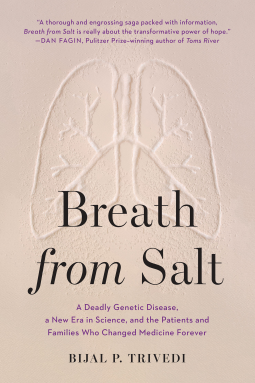


(Scroll down to see some science at work)
As a PhD researcher working on Cystic Fibrosis I immediately knew I had to get this ARC and read Breath from Salt, which will be published tomorrow on September 8, the 31st anniversary of the publication of the CFTR gene, mutations in which cause Cystic Fibrosis. I wanted to read it to get more background and personal stories, and I am also looking for accessible ways in which to introduce my thesis subject to my friends and family.
Breath from Salt aims to tell the story of Cystic Fibrosis from the early days before it was recognized, over the helpless days where the diagnosis was a (very) early death sentence, to the currently hopeful days where CF specific drugs that can restore the faulty protein have started to reach the market. This is the story of nothing short of a revolution – where Cystic Fibrosis helped to make sure that rare diseases (CF itself is considered the most common of the rare diseases) get the research and resources that are needed, and then again at the forefront of the treatment revolution that is called personalized medicine.
However, I suggest Breath from Salt should be re-titled An American History of Cystic Fibrosis.
The beginning was great! I was rather excited to be reading this, so I probably bothered a lot of people with my constant status updates. While I knew the main parts of story here, they are usually only summarized in review papers like “Dr. Dorothy Andersen was the first to describe CF in 1938…”. Breath from Salt however was adding the personal touch and anecdotes to these early discoveries that was exactly what I was hoping to find. Interspersed was the touching story of a family struggling with CF in a time there were so little options. Sad as it was to read about it, it also highlighted how far we have come from those days.
Next up, there was a lot of basic science to discover. After being able to recognize and diagnose Cystic Fibrosis, the next question was: what is going wrong in Cystic Fibrosis? This is essential to know in order to figure out how to fight the disease. Its clustering in families made clear there had to be a genetic cause, the salty sweat (people with CF taste salty) pointed towards a defect in salt transport. The unraveling of how (which part of the DNA was mutated) and what (which functions where the cells missing because of it) was super interesting to read for me. All of this is science that was performed before I was born, let alone read about CF, and it was great to see it all together in one place.
The gene hunt culminates with the discovery of the CFTR gene which was published on September 8, 1989 in three papers in Science. From there on the focus is on remedies for the disease. And after a very short stint into gene therapy the focus becomes the collaboration of the Cystic Fibrosis Foundation and Aurora (later: Vertex) in the search for so-called CFTR modulators, which would restore the faulty CFTR protein. The story of the CFF was interwoven throughout the earlier parts as well, showing how it became a large and successful patient organization which had the means to hire a company to start working on Cystic Fibrosis (and not for example cancer or diabetes or any other much more common diseases).
This was the part I knew best already – since it was all more recent. It was interesting to read how these molecules which I work with on a daily base (VX-770; VX-809/661; VX-445) came to be. However, I was a little bit disappointed because it no longer focused on other scientific discoveries besides the Vertex development of CFTR modulators. One of the amazing things in the first parts was how it showed that science is a group effort. Discoveries are made because groups at different labs work together and build onto the results from one another to find the gene, discover the protein, and what the mutations do to disrupt it. There was very little non-Vertex related science in the latter part of the book. There is a very short mention that CFF funds some other pharmaceutical companies as well, but that is about it. I suggest this website if you are interested in all ongoing clinical trials into new treatments: https://www.cff.org/Trials/pipeline
Which brings me to my suggested title. There is little to no mention of Europe. Cystic Fibrosis is at least as common in Europe as it is in Northern America, and based on reading this book one might suggest there is no research at all across the pond. As a European-based CF researcher I found this a little unfair. Especially near the end when rare mutations (CF can be caused by different mutations, some of them are only found in a handful of people with CF, and there are no medicines yet for these mutations) are discussed I feel the European effort should have been acknowledged.
Because it does mention how CFF are engineering rare mutations in their models, and Vertex’ All in For CF Program, but it doesn’t talk for example about HIT-CF (https://www.hitcf.org/) the large ongoing European project with teams from the Netherlands, Belgium and Portugal where new drugs from multiple companies are tested directly on cells derived from people with these rare mutations. It doesn’t discuss the human intestinal organoid model (stem cells taken from a small, minimally invasive biopsy and then grown in a petridish where they form some kind of a mini-organ), which correlates very well with clinical data from people with CF. And since it is a minimally invasive procedure these are available from many, many patients and really allow to perform personalized medicine. (You can find the original paper describing the assay over here: https://www.nature.com/articles/nm.3201) 500+ pages and the only reference to organoids at all (it was lung organoids in this case) was to say that some researcher in the Netherlands (not mentioned by name) received some funding to study a certain type of mutation.
Since a picture says more than a thousand words and this assay is something I also perform, I wanted to show you an example. The organoids in this are the small roundish green objects, they are stimulated at the beginning in order to try to open the CFTR channels. If it works it will result in a swelling of the organoids. Below is one sample without any treatment – no swelling; and with treatment with CFTR modulators described in Breath from Salt. You can see for yourself what happens 😊


These things obviously only bothered me because I already knew a lot about the subject (and I am from Europe). As an introduction I think it would work really well, not just into Cystic Fibrosis but also into the ideas and challenges of personalized medicine. Or for anyone who likes to read science books. For me, the recap of all the ‘old’ science was great, and I wouldn’t have minded if the focus had remained more on the science part rather than the business part after the discovery of the gene. I found it rather readable and accessible, but I can’t really vouch for people unfamiliar with many of the scientific terms used.
I would certainly recommend Breath of Salt – just keep in mind that while it covers a lot already, there is still a lot more going on.
Thanks to the publisher and Netgalley for providing me with a free electronic copy of this book in exchange for an honest review!
Breath from Salt – Bijal P. Trivedi

That is an amazing review. Thanks for adding the additional context of your own experience and expertise into this.
LikeLiked by 2 people
Thank you! It’s probably the longest review I’ve ever written. And I could talk about CFTR for days 😉. I’ve tried to keep the real science talk a bit down, but I just had to include some organoids from my own experiments since it felt unjust they were not given any attention…
LikeLiked by 1 person
I always wonder when this happens (US centric focus) if it’s because the author/publisher never imagined it would be sold internationally, or if the author just didn’t have the financial backing to do the wider research, or in this case, if the financial backing came from a specific source that lent itself to a narrower view of things. Sounds like it was a good read though, even if not as good as it might have been.
LikeLiked by 2 people
Also – I love the CFTR illustrations. Thanks for adding those in.
LikeLiked by 1 person
Thank you! It felt unfair that the organoids model didn’t get any attention in the book, since it is a wonderful tool for personalized medicine. And this probably was the only chance I’ll have to include one of my own experiments in my reviews 😉 I could talk about CFTR for days…
LikeLiked by 1 person
And I could listen! I’m a science nerd with math issues, so I have to live vicariously through books/mags and friends. 🙂
LikeLike
That’s great! There is so much to learn out there, and I think it is a great mindset to want to know more about things!
LikeLiked by 1 person
I have always found it very strange. Were I to write a history of something – I could never imagine not adding in the US or other continents in my research.
It’s difficult to say, but it seems well-researched, so I would probably guess the latter. Although it’s an American publisher and it is also very possible that they didn’t expect it would reach continental Europe.
LikeLiked by 2 people